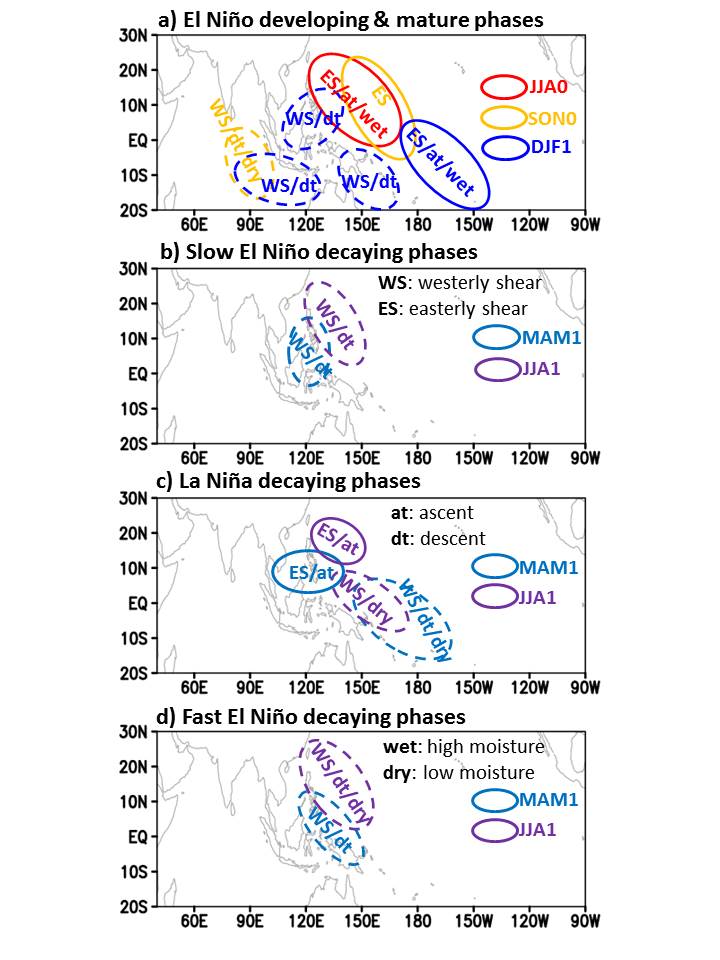State Key Laboratory of Numerical Modeling for Atmospheric Sciences and
Geophysical Fluid Dynamics (LASG)
Institute of Atmospheric Physics, Chinese Academy of Sciences

Vol. 3/No.3 August 2017
Spatiotemporal change of ISO intensity over the tropical Indo-Pacific Ocean associated with El Niño and La Niña events
Highlights:The ISO intensity change features a contrast between the tropical southeastern Indian Ocean and the tropical western North Pacific in the ENSO developing phases. The 10-20-day and 30-60-day ISO intensity change displays a remarkable difference in the ENSO developing and decaying summers.
Summary: Regarding the modulation of ENSO on the ISO intensity, previous studies are mostly concerned with the equatorial Indo-Pacific regions during El Niño events with less attention to the ISO intensity change during La Niña events or they didn’t separate the El Niño and La Niña events. Is the ISO intensity change opposite between the El Niño and La Niña years in the tropical Indo-Pacific region? There are two prominent ISOs (10-20-day and 30-60-day) that display distinct paths of propagations. Is the modulation of ENSO on the two ISOs different?
Recently, Prof. WU Renguang and Dr. SONG Lei documented systematically the spatial-temporal evolution of the ISO intensity change over the tropical Indo-Pacific associated with ENSO and compares the intensity change between El Niño and La Niña years and between the 10-20-day and 30-60-day ISOs. The ISO intensity change tends to be opposite between El Niño and La Niña years in the developing and mature phases. The intensity change features a contrast between the tropical southeastern Indian Ocean and the tropical western North Pacific (WNP) in the developing phases and between the Maritime Continent and the tropical central Pacific in the mature phase (Fig. 1a). In the decaying phases, the intensity change shows notable differences between El Niño and La Niña events and between fast and slow decaying El Niño events (Figs. 1b-d). Large intensity change is observed over the tropical WNP in the developing summer, over the tropical southeastern Indian Ocean in the developing fall, and over the tropical WNP in the fast decaying El Niño summer due to a combined effect of vertical shear, vertical motion, and lower-level moisture. In the ENSO developing summer and in the El Niño decaying summer, the 10-20-day ISO intensity change displays a northwest-southeast tilted distribution over the tropical WNP, whereas the large 30-60-day ISO intensity change is confined to the off-equatorial WNP (Fig. 2a). In the La Niña decaying summer, the 30-60-day ISO intensity change features a large zonal contrast across the Philippines, whereas the 10-20-day ISO intensity anomaly is characterized by a north-south contrast over the tropical WNP (Fig. 2b).

Figure 1. Schematic diagrams illustrating the 10-20-day ISO intensity change and the main factors during (a) El Niño developing and mature phases, (b) slow El Niño decaying phases, (c) La Niña decaying phases, and (d) fast El Niño decaying phases. Solid and dashed shapes denote intensity increase and decrease, respectively. MAM, JJA, SON, and DJF denote spring (March-April-May), summer (June-July-August), fall (September-October-November), and winter (December-January-February), respectively. Symbols “0” and “1” after the season denote ENSO developing and decaying years, respectively.
Figure 2. Schematic diagrams illustrating the difference of 10-20-day (red) and 30-60-day (blue) ISO intensity changes during (a) El Niño developing summer and (b) La Niña decaying summer. Solid and dashed shapes denote intensity increase and decrease, respectively.
Reference:
Wu, R. and L. Song, 2017: Spatiotemporal change of intraseasonal oscillation intensity over the tropical Indo-Pacific Ocean associated with El Niño and La Niña events. Climate Dynamics, online, doi:10.1007/s00382-017-3675-0.
https://link.springer.com/article/10.1007/s00382-017-3675-0
Contact: Wu Renguang, renguang@mail.iap.ac.cn
E-mail: lasg_newsletter@lasg.iap.ac.cn
Editors: Chuanyi Wang (wangcy@lasg.iap.ac.cn), Kangjun Chen(ckj@lasg.iap.ac.cn)